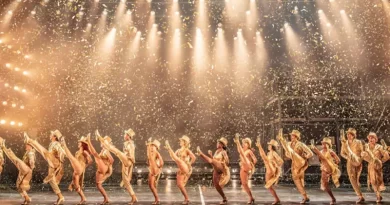“Crooked Cross” at the Mint Theatre, New York
Glenda Frank in Manhattan
13 October 2025
★★★★☆
Many of us believed that the Shoah, the Nazi extermination of six million Jewish civilians and almost that number of “undesirables,” was kept secret until the 1940s, but Crooked Cross (Sally Carson’s play which she adapted from her earlier novel) brought a clear depiction of the escalating horrors to the British stage in Birmingham in 1935 and to London’s West End in 1937. Both the play and the novel were reviewed in major newspapers with The Times of London for January 1937 noting “the temperate wisdom with which the play presents its facts”.
The current revival at the Mint Theatre on Theatre Row brings us this important addition to our understanding. Out of print since 1934, the novel has been reissued by Persephone Books this year in both hard copy and a Kindle version. Carson’s play is another discovery by Jonathan Bank, artistic director of the Mint, who also directed it. Bank has been producing forgotten gems since 1995, many of them by women whose plays were once staged in prominent playhouses.
Crooked Cross is remarkable for its calm, sociological tone as it traces the rise of Nazi madness through the eyes of the Klugers, a working-class family. To them it simply offers welcome career paths. They are indifferent to the misery unfolding beneath the surface. Beneath the surface, not hidden from anyone in the town! They not only witness the brutality toward old friends, they participate. Helmy (Gavin Michaels) and Erich (Jakob Winter), the Kluger sons, had been marginally employed after World War I. One was a ski instructor; one slept with rich women. While the mother (Kate Firth) fusses over the family, the world outside is erupting. The sons delight in the uniforms, the group camaraderie — and the casual, violent fun of attacking what they call the non-Germans whose family roots may have gone back generations. They encourage their father (Liam Craig) to join the Party to improve his chance of a promotion.
Lexa (Ella Stevens), their sister, is devoted to her fiancé, Moritz Weissman (Samuel Adams), a talented Jewish physician who repaired Herr Kluger’s war wounds, giving him a new lease of life. Lexa and Moritz are the play’s Romeo and Juliet. As Hitler gains power, the Weissmans are fired and are forced from their home into a run-down studio apartment. Moritz, a Catholic convert, has neither the funds nor the desire to leave Germany. He believes the abuses will pass until his father, a former university professor, is murdered in a “joke” played by drunken German soldiers. Lexa convinces him they need to escape to Vienna through a mountain pass which they had not realized was heavily guarded. Contemporary audiences with historical perspective know that Vienna is a hopeless move but the Anschluss, the Nazi annexation of Austria, will not happen until 1938.
Carson’s novel was written after a visit to friends in Bavaria. The play opens with the lighting of a Christmas tree and the singing of carols in 1932. The title is a reference to a giant swastika on the mountains which was celebrated with fireworks on New Year’s Eve, 1933. The last scenes are set on Midsummer Night, 1933. The lovers are on a mountain pass, hiding from armed Nazi patrols.
Lexa is the heart of the play, faithful and clear-sighted. Caught between family and her future husband, alternatively arguing against the Nazi dictates and seeming to welcome the romantic advances of a Nazi officer, Lexa must be played with great charm and a shade of ambiguity. Ella Stevens, a recent Northwestern University graduate in her New York debut, delivers on those big requirements. The play itself feels a little dated and some of the actors have not fully absorbed their characters yet. But nothing drags and in some of the scenes, particularly the Nazi ballroom celebration, danger is a palpable presence. The Mint has a knack for finding impressive designers, but the costumes by Hunter Kaczorowski (Henry Hewes Design Award nomination) are standouts both in fashion detailing and in capturing the feel of the period.








